Souvenir Sheet: Joining Hands to Protect the Environment (Taiwan (Republic of China) 2016)
Joining Hands to Protect the Environment (Taiwan (Republic of China) 2016)
22 October (Taiwan (Republic of China) ) within release Philataipei 2016 goes into circulation Souvenir Sheet Joining Hands to Protect the Environment face value 47 Taiwanese new dollar
| Souvenir Sheet Joining Hands to Protect the Environment in catalogues | |
|---|---|
| Michel: | Mi: TW BL207 |
Souvenir Sheet is vertical format.
Environment DayAlso in the issue Philataipei 2016:
- Stamp - A New Vision through Design face value 25;
- Stamp - A New Vision through Design face value 9;
- Souvenir Sheet - A New Vision through Design M/S face value 102;
- Souvenir Sheet - Charity Around Taiwan face value 42;
- Se-tenant - Having Fun with Animation face value 25+5;
- Souvenir Sheet - Having Fun with Animation M/S face value 60;
- Souvenir Sheet - Joining Hands to Protect the Environment face value 47;
- Souvenir Sheet - Joining Hands to Protect the Environment face value 47;
- Stamp - Forests face value 15;
- Souvenir Sheet - Charity Around Taiwan face value 42;
- Se-tenant - A New Vision through Design face value 25+9;
- Stamp - Oceans face value 32;
- Stamp - Little Yam receiving a letter face value 25;
- Stamp - Little Yam mailing a letter face value 5;
- Stamp - Charity Around Taiwan face value 17;
- Stamp - Charity Around Taiwan face value 25;
- Souvenir Sheet - A New Vision through Design M/S face value 102;
- Se-tenant - A New Vision through Design face value 9+25;
- Souvenir Sheet - Having Fun with Animation M/S face value 60;
- Souvenir Sheet - A New Vision through Design M/S face value 102;
Souvenir Sheet Joining Hands to Protect the Environment it reflects the thematic directions:
A coral reef is an underwater ecosystem characterized by reef-building corals. Reefs are formed of colonies of coral polyps held together by calcium carbonate. Most coral reefs are built from stony corals, whose polyps cluster in groups.
Environmental protection is the practice of protecting the natural environment by individuals, groups and governments.Its objectives are to conserve natural resources and the existing natural environment and, where it is possible, to repair damage and reverse trends.
In botany, a tree is a perennial plant with an elongated stem, or trunk, supporting branches and leaves in most species. In some usages, the definition of a tree may be narrower, including only woody plants with secondary growth, plants that are usable as lumber or plants above a specified height. Trees are not a taxonomic group but include a variety of plant species that have independently evolved a woody trunk and branches as a way to tower above other plants to compete for sunlight. In looser senses, the taller palms, the tree ferns, bananas and bamboos are also trees. Trees tend to be long-lived, some reaching several thousand years old. The tallest known tree, a coast redwood named Hyperion, stands 115.6 m (379 ft) high. Trees have been in existence for 370 million years. It is estimated that there are just over 3 trillion mature trees in the world. A tree typically has many secondary branches supported clear of the ground by the trunk. This trunk typically contains woody tissue for strength, and vascular tissue to carry materials from one part of the tree to another. For most trees it is surrounded by a layer of bark which serves as a protective barrier. Below the ground, the roots branch and spread out widely; they serve to anchor the tree and extract moisture and nutrients from the soil. Above ground, the branches divide into smaller branches and shoots. The shoots typically bear leaves, which capture light energy and convert it into sugars by photosynthesis, providing the food for the tree's growth and development. Flowers and fruit may also be present, but some trees, such as conifers, instead have pollen cones and seed cones; others, such as tree ferns, produce spores instead. Trees play a significant role in reducing erosion and moderating the climate. They remove carbon dioxide from the atmosphere and store large quantities of carbon in their tissues. Trees and forests provide a habitat for many species of animals and plants. Tropical rainforests are one of the most biodiverse habitats in the world. Trees provide shade and shelter, timber for construction, fuel for cooking and heating, and fruit for food as well as having many other uses. In parts of the world, forests are shrinking as trees are cleared to increase the amount of land available for agriculture. Because of their longevity and usefulness, trees have always been revered, with sacred groves in various cultures, and they play a role in many of the world's mythologies.




